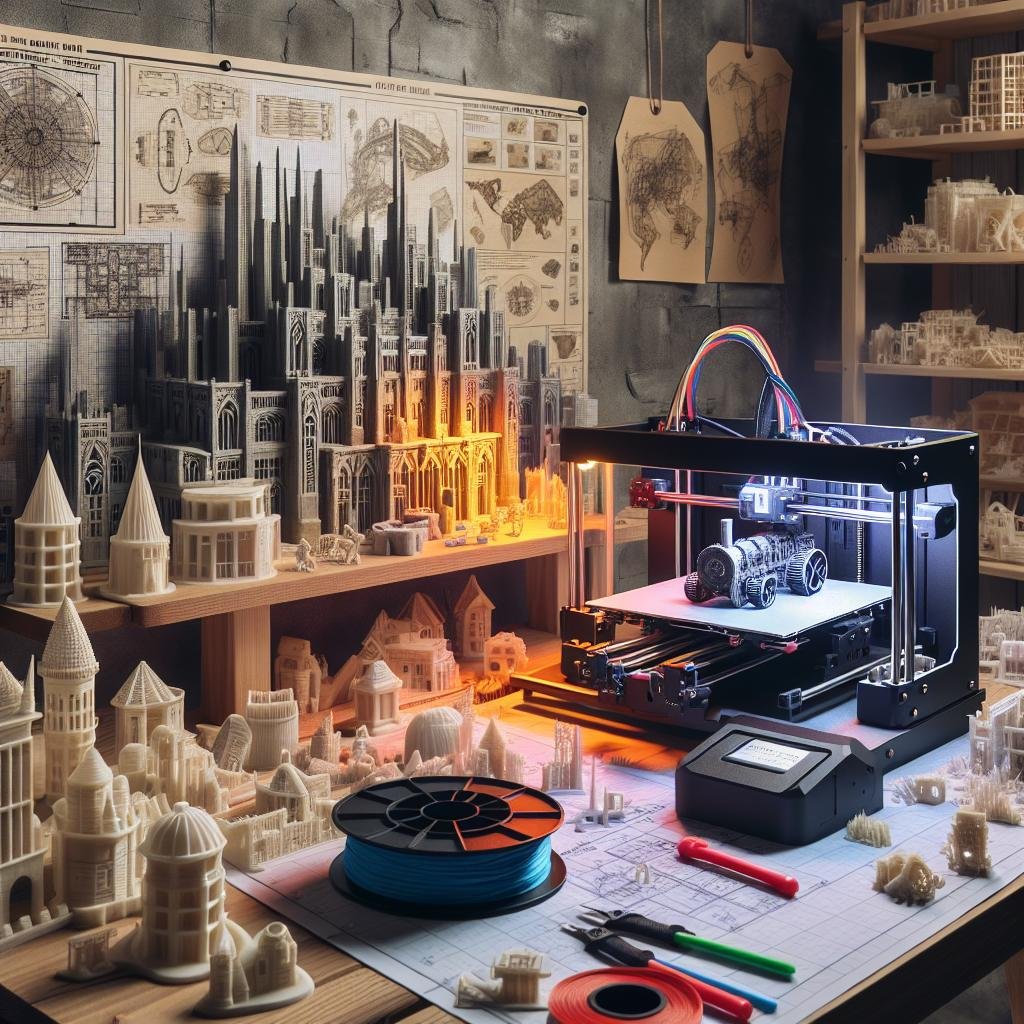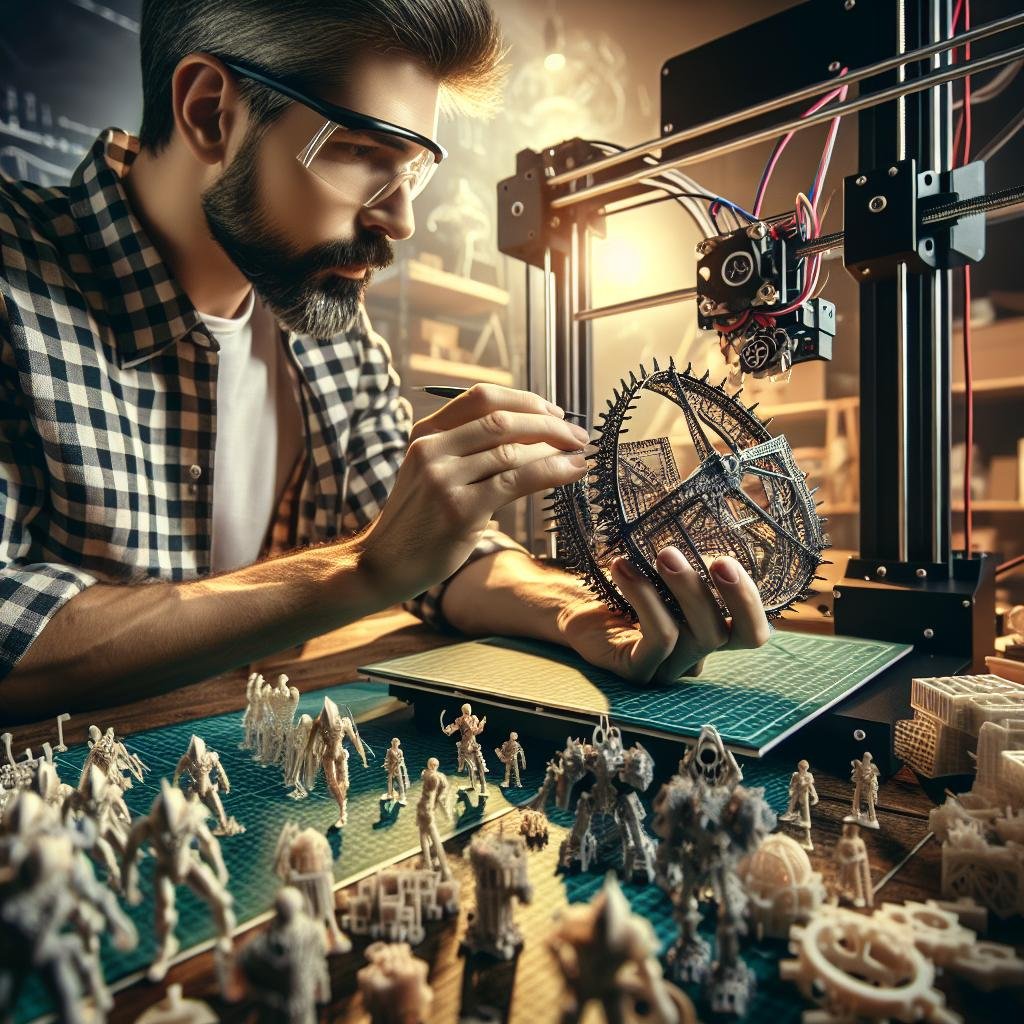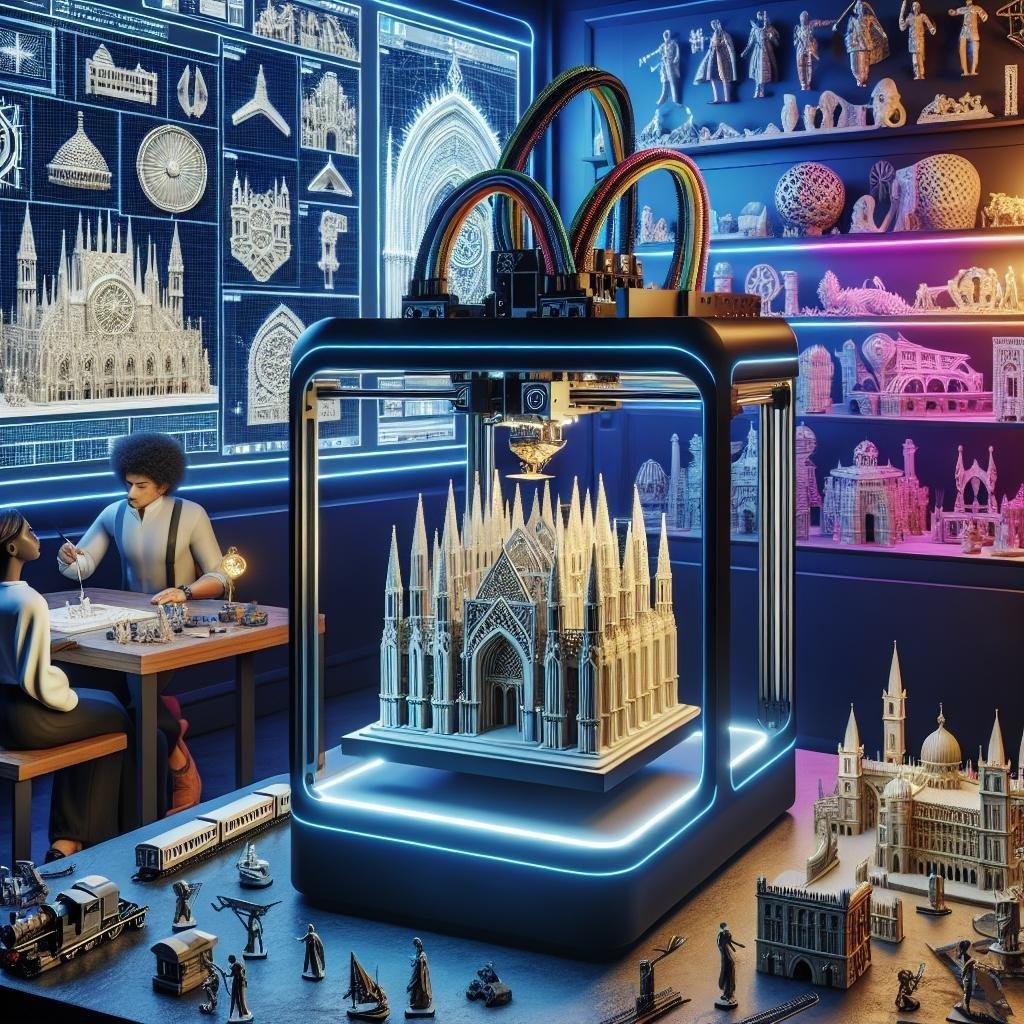In a world where imagination knows no bounds, the art of creating custom scale models and miniatures has found a new ally in the realm of 3D printing. Imagine holding a tiny, precise replica of your favorite architectural marvel or a detailed miniature of a fictional character, crafted with the same intricate details you once only dreamed of sketching. Welcome to the enchanting world of 3D printing, where digital dreams turn into tangible treasures. Whether you’re an experienced model enthusiast eager to explore new horizons or a curious novice, this guide is your passport to bringing detailed, bespoke miniatures to life. Let’s embark on this creative journey together,where the only limit is the boundless stretch of your imagination.
Choosing the Right Materials: A Miniature’s Best Friend
| Material | Strength | Detail | Cost |
|---|---|---|---|
| PLA | Medium | High | Low |
| ABS | High | Medium | Medium |
| Resin | High | Very High | Varies |
When embarking on your miniaturization journey, selecting the perfect material can make the difference between a masterpiece and a “meh” piece. PLA is a beginner’s best ally: inexpensive,readily available,and perfect for capturing fine details. If you’re aiming for highly intricate designs, resin offers unmatched precision and a smoother finish. It’s ideal when you envision your model displaying every nook and cranny, yet it’s worth noting resin’s higher learning curve and cost. ABS, known for its durability, is a friend in disguise, offering stronger bonds with organic shapes, although it may demand a bit more patience due to its warping tendencies.
Consider your project’s needs by balancing strength,detail,and budget. If your piece will bear weight or withstand handling, ABS‘s robustness is a clear choice. For static display models that require high fidelity, resin remains unrivaled. Always remember:
- Durability: Consider handling and environmental exposure.
- Detail: The sharper,the better for display.
- Budget: Plan ahead for materials and machine maintenance.
With the right choice,each curve and angle of your miniatures will stand out,ensuring your models are more than mere figures; they’re stories waiting to unfold.

mastering the Art of Design: Software Tips for Beginners
Embarking on your journey to create custom scale models and miniatures through 3D printing can be both thrilling and rewarding. As a beginner,mastering design software is your frist step toward bringing your ideas to life. Start with user-friendly programs such as Tinkercad or Blender, which offer a gentle learning curve yet robust capabilities. Dive into tutorials that cover the basics of manipulating shapes, scaling, and adding intricate details. Remember, every expert was once a beginner, so embrace experimentation and don’t shy away from making mistakes.
- Choose the Right Software: Opt for software that matches your skill level and project needs.
- Explore Tutorials: Engage with online platforms offering extensive guides and walkthroughs.
- Practice Makes perfect: dedicate time to practice and refine your skills regularly.
Once you’ve wrapped your head around the design basics, it’s time to transform those digital creations into tangible objects. Be mindful of the print settings; scale models demand a careful balance between detail and durability.Using the right materials is crucial, as different filaments offer varying strengths and finishes. refer to the table below for guidance on material choice:
| Material | Characteristics | best Use |
|---|---|---|
| PLA | Easy to print,minimal warping | Basic models and miniatures |
| ABS | Durable,prone to warping | Functional parts requiring strength |
| Resin | High detail,smooth finish | Detailed miniatures,prototypes |
Utilizing these tips and insights will help you refine your process and elevate your projects from mere ideas to awe-inspiring models. With patience and creativity, your masterpieces will undoubtedly garner admiration from enthusiasts and collectors alike.

From Prototype to Perfection: Refining Your 3D Prints
Transforming your initial drafts into precision-crafted miniatures involves a keen eye for detail and a readiness to iterate. To begin with, iterative testing is your best friend. It’s essential to print multiple versions, experimenting with different settings to see what works best for your model. Ensure you have calibrated your 3D printer accurately; a tiny misalignment can make a big difference in the end product. Common tweaks include adjusting the layer height for smoother finishes, increasing or decreasing infill for the right balance of structure and weight, and fine-tuning the print speed for precision. Remember, even the best prototypes might need sanding, priming, or a touch of paint, so keep your post-processing tools at the ready.
To guide your refinement journey, a table of common troubleshooting tips might prove invaluable:
| Issue | Solution |
|---|---|
| Warping | Adjust bed temperature, use a heated nozzle, or add rafts. |
| Layer Shifts | Ensure that belts are tight and check for obstructions. |
| Stringing | Optimize retraction settings and decrease nozzle temperature. |
- Experiment with supports: Custom supports can lead to a cleaner and more accurate model.
- Explore different materials: Each filament has a personality; get to no them to match your desired finish.
- Use software aids: Simulation tools can predict potential pitfalls before even starting a print.
Finishing Touches: Painting and Detailing for a Lifelike Look
bringing your 3D printed scale models and miniatures to life is an art that combines technique with a dash of creativity. Start by choosing the right primer, as it acts as a foundation for your paint, helping colors to adhere beautifully while revealing minute details in your model’s surface.Opt for a spray primer for a smooth base, especially for larger pieces. Acrylic paints are popular due to their vibrant hues and ease of use, allowing for seamless blending and layering. For those intricate paint jobs, fine-tipped brushes will be your best friends, perfect for adding precision to the tiniest details. When using an airbrush,remember to maintain a steady hand for even coats and softer blends,bringing dynamic fades to capes,wings,and more. Layering different shades can introduce depth and realism to any part of your model, whether it’s a dragon’s scales or a warrior’s armor.
- Primers: essential for smooth colour submission.
- Brush Type: Variety is key - from broad strokes to pinpoint precision.
- Paint Choice: Acrylics are favored for their versatility and vibrant results.
Besides painting, small embellishments and weathering techniques add that extra dimension to your creation. Dry brushing can highlight textures and edges, enhancing the intricacies effortlessly. As a finishing touch, fine-tuning your miniatures with decals can offer authenticity, transforming them with badges, insignia, or even simulating cracks and battle-worn surfaces.If you’re a fan of realism, consider crafting a diorama base; add elements like miniature foliage or sand to reflect their environment. A clear topcoat not only offers a protective shield, maintaining your model’s vibrant finish, but also adds a subtle sheen or matte effect as per your preference. Below is a quick guide to the tools and outcomes you might expect:
| Technique | Tool | Outcome |
|---|---|---|
| Dry Brushing | Flat Brush | Highlights & Texture |
| Decals | Tweezer & Water | Detailed Emblems |
| Diorama Base | Glue & Scenery Kit | environmental Realism |
| Clear Topcoat | Spray Can | Protection & Sheen |
Q&A
Q&A: How to 3D Print Custom scale models and Miniatures
Q1: What makes 3D printing ideal for creating custom scale models and miniatures?
A1: 3D printing is a game-changer for anyone dreaming of crafting their own scale models and miniatures. It offers unparalleled precision, allowing you to capture even the tiniest details of your design. Plus, it’s highly customizable, so you can create unique pieces that truly reflect your vision. Whether you’re replicating the curves of a vintage car model or the delicate features of a fantasy miniature, 3D printing brings creativity to life with ease and accuracy.
Q2: What materials should I use for printing my miniatures?
A2: Great question! The material you choose will considerably impact the look and feel of your final product. For intricate details, resin is often preferred due to its smooth finish and high detail resolution. PLA is another popular choice, beloved for its eco-friendliness and ease of use, especially for beginners. For more durable or functional pieces, ABS might be your go-to. Each material has its own charm, so it’s about matching them to your project’s needs.
Q3: How can I ensure my models have the right scale and proportions?
A3: Ah, the art of scaling! First, gather accurate measurements or reference images of the item you wish to replicate. Using 3D design software,you can input these measurements to maintain authenticity in scale. Tools like sliders or numerical inputs within these programs help finesse details to ensure proportionate scaling. It’s a bit of a balancing act,but with practice,you’ll become adept at translating real-world dimensions into your creations.
Q4: Are there any tips for designing complex models?
A4: Absolutely! Start small and progressively build up to more complex designs as your confidence grows. Break intricate models into smaller components that are easier to manage and then assemble them post-printing. Don’t shy away from using pre-made templates or assets for certain parts – they can be excellent timesavers. Remember, experimentation is key, and perfection comes with practice, so let your creativity flow and take risks!
Q5: What software would you recommend for beginners learning to design 3D models and miniatures?
A5: If you’re just dipping your toes into the world of 3D design, platforms like Tinkercad or SketchUp are fantastic starting points. They have intuitive interfaces and great tutorials for beginners.As you become more comfortable, you might want to graduate to software like Blender or Fusion 360, which offer advanced tools and functionalities. Remember, every designer was once a novice, so enjoy the learning journey!
Q6: How can I improve the quality of my miniature prints?
A6: To elevate the quality of your prints, focus on fine-tuning your printer settings.Layer height, print speed, and temperature can all play a role in achieving crisp details. also,consider post-processing techniques like sanding,priming,or painting,which can bring your miniatures to life and add an extra touch of professionalism. And don’t forget the power of community - joining forums or local maker groups can give you access to tips and tricks from seasoned creators.
Q7: Any advice on troubleshooting common printing issues?
A7: Of course! Many first-timers hit a snag or two, but don’t worry-it’s all part of the process. Having issues with adhesion? Try leveling the bed or using an adhesive agent like glue stick or painter’s tape. Experiencing clogged nozzles? Regular cleaning and maintenance should do the trick.When it comes to layer shifting or inconsistent extrusion, double-check your settings and tighten loose belts. Patience and perseverance are your greatest allies here!
As you embark on this exciting journey of 3D printing custom models and miniatures, remember to embrace the ups and downs and let each project be a stepping stone to even greater creations. Happy printing!
Future Outlook
and there you have it-a colorful gateway into the enchanting world of custom scale models and miniatures brought to life by the magic of 3D printing. As you embark on this creative journey, remember that every print is a step into a realm where imagination meets reality. With each layer laid down, you’re not just crafting models but building stories, dreams, and worlds from your very fingertips.
Whether you’re bringing to life the sprawling landscapes of fantasy realms, meticulous replicas of historical moments, or designing unique versions of your favorite collectibles, the power of 3D printing transforms your vision into tangible artistry. So, take the plunge and let your ideas take shape. Experiment, learn, and most importantly, enjoy the process!
As you refine your skills, may your workshop resonate with the gentle hum of the printer and beams of curiosity. Let this guide serve as the stepping stone to unleashing your creativity and unlocking the endless possibilities that await in the realm of miniature masterpieces. Happy printing!

